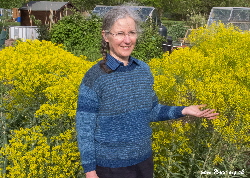12 Steps to Extraction of Woad Dye - Introduction & Requirements
1. List of requirements
2. Preparing woad leaves
3. Extracting woad pigment
 Extracting woad is something you should try at least once as it is so exciting. To get the blue pigment from woad, it is important to use leaves from the plant’s first summer. Harvest the leaves in late July and August, preferably during a warm spell. Leaves need to be fresh and should be used as soon as possible after harvesting as the pigment can deteriorate rapidly. Having said that, I have had dyers telling me that they got some blue from second-year plants and from dried leaves. Extracting woad is something you should try at least once as it is so exciting. To get the blue pigment from woad, it is important to use leaves from the plant’s first summer. Harvest the leaves in late July and August, preferably during a warm spell. Leaves need to be fresh and should be used as soon as possible after harvesting as the pigment can deteriorate rapidly. Having said that, I have had dyers telling me that they got some blue from second-year plants and from dried leaves.
The woad leaves don’t have a blue pigment inside them. Instead they have a ‘precursor’, a chemical that can be transformed into the blue pigment. There is a higher concentration of precursor during a hot spell of weather and this is the best time to harvest the leaves. As it starts to get cold in the autumn, the amount of precursor decreases and after the first frost there is hardly any woad precursor left in the leaves. Most of the precursor disappears by the time the woad plant is in flower in its second year.
By steeping the woad leaves in warm water you break down the waxy coating on the leaves and release chemical precursors into the water. When you add soda ash, you raise the pH making the solution alkaline. When you whisk the solution, you add oxygen. This creates a chemical reaction that forms the woad pigment. This pigment is insoluble in water and it settles on the bottom of the container. You can read more about the chemistry of woad extraction here.
The yield depends on the soil, how well the plants are fed and how warm the summer is. One woad plant produces about 700 grams of leaves and you will get between 1 and 4 grams of blue pigment from 1 kilo of leaves. 1 gram of woad will dye about 20 grams of fibre.
List of requirements for woad extraction:
a) To harvest the leaves and extract the pigment you will need:
- secateurs
- 10 litre stainless steel saucepan or stockpot
- rain water (optional)
- thermometer
- ice cubes (optional)
- colander
- rubber gloves
- bucket
- Pyrex jug
- soda ash
- pH paper
- plastic plant pot (with holes in the bottom) or a hand whisk
- woad leaves :-)
b) To settle and clean the pigment you will need:
- plastic yogurt pot
- several empty coffee jars
- glass siphon (turkey baster)
- funnel (optional)
- piece of habotai silk (optional)
12 Steps to Extraction of Woad Dye (now on 2 pages)
Page 1. Harvesting woad leaves (opens a new page)
1. Harvesting woad leaves
2. Tearing the woad leaves
3. Steeping the woad leaves
4. Cooling the woad liquid
5. Straining the woad liquid
6. Adding soda ash
Page 2. Extracting the woad pigment (opens a new page)
7. Aerating the woad liquid
8. Settling out the woad pigment
9. Cleaning the woad pigment
10. Drying the woad pigment
11. Filtering the woad pigment
12. Dyeing with woad
Looking for the old page on woad pigment extraction?
The old text & photos for extracting woad pigment are here.
Top of page
|